Bookshelf
by Paddy Macdonald
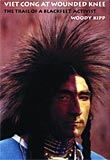 Viet Cong at Wounded Knee: The Trail of a Blackfeet
Activist
Viet Cong at Wounded Knee: The Trail of a Blackfeet
Activist
By Woody Kipp ’91, M.F.A. ’97
Lincoln, NE: University of Nebraska Press, 151 pp., $24.95
Woody Kipp recounts his life as a Blackfeet tribe member, high school basketball player, Marine Corps Vietnam veteran, hard-drinking cowboy, consciousness-raising UM student, and participant in the American Indian Movement in his close-to-the-bone autobiography. Revisiting a trail littered with womanizing, alcoholism, and jail time—that led him from the Blackfeet Reservation of his birth to a terrible moment of reckoning on the plains of South Dakota—Kipp tells a story of native values and practices uneasily crossed with teenage angst and quintessentially American temptations and excesses.
Striking passages throughout the book offer glimpses into American Indian culture, from a gripping account of an unsuccessful attempt to break a horse to an insightful description of native singing: “The tribal songs connect existentially; they are patterns of energy that allow immersion into the energies around us, telling us who we are.”
Strung together like clay beads on a string are sad, sad, stories, like the one in which two brothers-in-law engage in a barroom brawl—over “something about horses”—resulting in the death of one of the men. The other man, “Truman,” was initially charged with manslaughter, a charge that was later dropped. Truman’s story has a happier ending than most. “But we can change,” writes Kipp. “That fight with his brother-in-law was Truman’s last bout with alcohol. . . . After the trauma of the barroom ordeal dissipated, Truman began hosting youth rodeos. The theme behind the youth rodeos was that one doesn’t have to be a drinking, fighting, whoring, whiskey-drinking individual to be a cowboy.”
The book sometimes lacks detail that would help the reader more fully understand Kipp’s motivations and choices, but his straightforward and revealing style make clear Kipp’s feelings about the Native American experience—Indians “surviving but not surviving well because of the disruption of their traditional lifeways.”
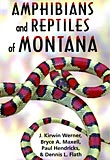 Amphibians and Reptiles of Montana
Amphibians and Reptiles of Montana
By J. Kerwin Werner, Bryce A. Maxell, M.S. ’98, Paul
Hendricks ’75, M.A. ’87, and Dennis L. Flath, M.S.
’70
Missoula: Mountain Press Publishing, 2004, 262 pp., $20.00
Every creepy-crawler from the pygmy short-horned lizard to the rough-skinned newt is covered in this comprehensive guide to Montana’s herpetology. With brilliantly colored photographs, a glossary, and morphological drawings, the book displays fascinating and detailed information on our native, cold-blooded vertebrates.
It is rife with oddball factoids. Take the Western skink. A smooth-scaled, striped lizard about seven inches from head to tail, the skink forages in coniferous forests, especially communities of Ponderosa pine and Douglas fir. Its predators—rattlesnakes, hawks, and coyotes, among others—are often foiled in their attempts to capture the skink. When grasped, the nether end of the lizard’s blue-tinged tail breaks off and continues to wiggle, distracting the predator, allowing the skink to—well—slink away.
Woodhouse’s toad, which resembles a fistful of pebbly mud and resides in the Missouri and Yellowstone river valleys, makes a loud, high-pitched, nasal “waaaaaaaah” similar to a baby’s cry. Tiger salamanders, which can be found in basements, window wells, and prairie dog burrows, as well as glacial potholes, stock reservoirs, and ponds, fend off predators by way of noxious secretions.
The book features dramatic descriptions of phenomena we haven’t much thought about since grammar school, like the metamorphosis of a tadpole into a frog: development of front and hind legs, absorption of the tail, and conversion of its entire system from the intestine to the jaw. Or the process of overwintering, when some amphibians and reptiles lower body temperatures and metabolic rates to the point of inactivity. Photographs range from close-ups of the ventral side of a spiny softshell to a gophersnake caught mid-meal as it devours a mouse. This field guide is a terrific tool for layperson and professional alike to identify the state’s frogs, toads, salamanders, turtles, lizards, and snakes. Readers will be surprised to learn of the magnificent variety of Montana’s amphibians and reptiles and their relationship to our ecosystems.
 The Best of Montana’s Fiction
The Best of Montana’s Fiction
Edited by William Kittredge and Allen Morris Jones ’93
Kittredge headed UM’s Creative Writing Program Guilford,
CT: The Lyons Press, 2004, 342 pp., $22.95
The newest collection of Montana-centered stories features violence, greed, perfidity, lies, guns, and bleak, punishing weather. As Richard Ford warns in the opening line of “Great Falls,” “This is not a happy story.”
“Days of Heaven” by Rick Bass is narrated by a ranch caretaker confronting a variety of predators, from the development-minded real estate agent, with his “narrow, close-together eyes . . . like raisins set in dough” to the agent’s client, an alcoholic New Yorker who “did something on the stock exchange” to the owls, moose, and ravens that inhabit the ranch.
The narrator radiates disgust for the deviant behavior and profiteering intentions he sees in the other two men, but is not immune to corruption himself: “ . . . how narrow the boundary is between invisibility and collusion. If you don’t stop it, if you don’t step up and single-handedly change things, then aren’t you just as guilty?”
Truth—and, more ominously, lies—rear up as thematic material in several stories.
In “Real Indians,” by Debra Magpie Earling, two siblings hitch rides up and down the reservation, playing on the prejudice and ignorance of the people who pick them up: “And we’d be what they wanted us to be, we’d be the lost tribe, we’d be the Mexican cherry pickers, we’d be the bored sons home for vacation.”
In Kevin Canty’s “Junk,” Jess Parker willingly accepts his ex-wife, Dorothy’s, lies. By the story’s end, Parker has become so entangled in the mess Dorothy brought back to town with her that he can’t find a way out—can’t tell his girlfriend, Maggie, what she needs to know: “ . . . I couldn’t tell her about Dorothy, there in the cafeteria—it was too bright, too normal, too much in the light of day. What I really needed was three in the morning, a couple of drinks.”
Throughout the collection curls a pervasive sense of loneliness, a feeling expressed by Claire Davis in “Grounded”: “Marriage and friendship, sons and daughters, were just a respite between you and the knowledge that every choice you make is yours alone.”
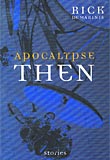 Apocalypse Then
Apocalypse Then
By Rick DeMarinis ’61, M.A. ’67
New York: Seven Stories Press, 2004, 268 pp., $22.95
Quick dark humor and a certain incendiary zanines characterize Rick DeMarinis’s latest collection of stories.
DeMarinis’s characters are irreverent: “I learned to distance myself from anyone who had a ‘bright’ idea,” says the narrator in “Handyman.” “Incompetence was often rewarded in the aerospace business,” Moss remarks in “Structure.” “They come and they go,” says Nick’s date, Lana Faye, in “A Forty-Nine Pound Man,” “Everyone’s a temp.” These people aren’t particularly comfortable in the world: “I was almost fifty and still feeling my way in the dark,” says one man. “I’m always aware of the Worst Case Scenario,” says another.
Most have jobs, and they’re all of a certain ilk: evaluating satellite photographs for the Forest Service; teaching “techie-wannabees” at Western States Institute of Mining and Metallurgy; or stuck “out in the boonies, driving from one Minuteman silo to the next collecting Unplanned Event Records.”
The characters’ names and physical attributes have a hilarious specificity: Winona Mufkey; Hans Ludens; Ursula Klock; and Billie Blood. One fellow has a nose “as thick and red as a peeled yam.” Another man, seeing his own face in the mirror, remarks that he looks like “Jean Paul Sartre on a bad day.” An airline passenger sports “a big bushy beard you could hide a machine gun in.”
There’s something amiss with nearly everyone. The narrator of “Bête Noir” sleepwalks, awakening at his drafting table, or falling down the stairs, or at the wheel of his car. Moss, the major subject of the book’s first section, has a benign brain tumor “big as a golf ball.” The married couple in “Handyman” conduct disconnected, elliptical conversations such as this: “If I said, ‘Louise, why are the horses out in the yard instead of the corral,’ she would answer, ‘Doug Mayberry’s axle is somewhere between Pocatello and Butte.’”
What the inhabitants of DeMarinis’s world may have in common is that they’re all poised somewhere between fear and fecklessness; conformity and abandon. As Nick admits to himself in “A Forty-Nine-Pound Man,” “He led a careful and structured existence because he was aware of how delicate the thread was that held things together.” Each character, in his own way, is steeped in the knowledge that “everyone’s a temp.”
BookBriefs
 Soldier-Artist of the Great Reconnaissance:
Soldier-Artist of the Great Reconnaissance:
John Tidball and the 35th Parallel Pacific Railroad
Survey
By Eugene C. Tidball ’53, J.D. ’55
Tucson: The University of Arizona Press, 2004, 226 pp.,
$39.95
This book examines the memoirs of Lt. John Tidball, who joined
Ameil W. Whipple’s survey team, which set out from Fort
Smith, Arkansas, in search for a route for a transcontinental
railroad.
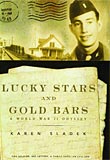 Lucky Stars and Gold Bars:
Lucky Stars and Gold Bars:
A World War II Odyssey
By Karen Sladek ’78
Seattle: Penlyric Press, 2003, 522 pp., $32.95
Letters written by Lt. Lyle Sladek from five continents to his
family in South Dakota serve as a coming-of-age tale as well as a
chronicle of one of our country’s most epic eras.
 Charles M. Russell:
Charles M. Russell:
The Storyteller’s Art
By Raphael James Cristy, M.A. ’92
Albuquerque: The University of New Mexico Press, 2004, 347 pp.,
$28.35
Well known for his art, Charles Russell was also an accomplished
author. Cristy shows how Russell amused his peers with stories
that delivered sharp observations of Euro-American suppression of
Indians and humorous treatment of wilderness and range
issues.
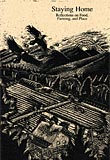 Staying Home:
Staying Home:
Reflections on Food, Farming, and Place
Edited by Kristi Johnson, M.S. ’04
Missoula: Garden City Harvest, 2004,159 pp., $14.95
This collection celebrates connection to the land and community.
Authors touch on the politics of food, loss and renewal, and
growing seasons—while showcasing the development of
Missoula’s Rattlesnake Community Farm.
 Movie Stars & Rattlesnakes
Movie Stars & Rattlesnakes
The Heyday of Montana Live Television
By Norma Ashby ’57
Helena: Farcountry Press, 2004, 160 pp., $19.95
Norma Beatty Ashby, one of Montana’s pioneer live
television personalities, recalls her twenty-six years at the
helm of Today in Montana.
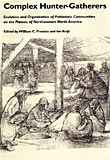 Complex Hunter-Gatherers
Complex Hunter-Gatherers
Edited by William C. Prentiss and Ian Kuijt
Prentiss is a UM associate professor of anthropology
Salt Lake City: University of Utah Press, 2004, 219 pp.,
$19.95
Contributors to this book seek to understand prehistoric social
organization, subsistence practices, and lifeways of those who
lived on the the Plateau region of the Pacific Northwest.